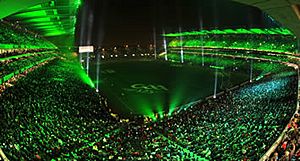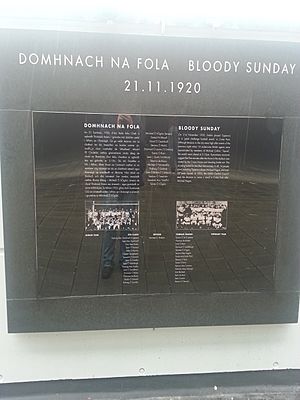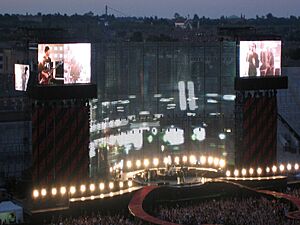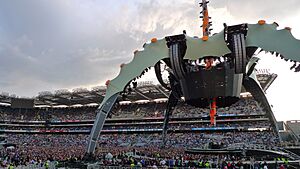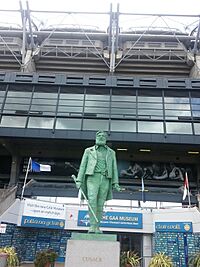Croke Park facts for kids
{{Infobox venue | name = Croke Park | native_name = Páirc an Chrócaigh | nickname = Croker | logo_image = Croke_Park_Logo.png | image = Croke Park from the Hill - 2004 All-Ireland Football Championship Final.jpg | image_alt = View from the Hill in Croke Park | location = Jones Road, Dublin 3, D03 P6K7, Ireland | coordinates = 53°21′39″N 6°15′07″W / 53.3609°N 6.2519°W | broke_ground = 1880 | opened = 1884 | renovated = 2004 | surface = Soil pitch | owner = GAA | cost = €266 million (2004 renovation) | architect = Gilroy McMahon | project_manager = Seamus Monahan & Partners | structural engineer = Horgan Lynch & Partners
| capacity =
- 82,300 (total)
- 69,100 (seated)
- 13,200 (terraced)
Croke Park (Irish: Páirc an Chrócaigh) is a huge stadium in Dublin, Ireland. People often call it Croker. It's named after Archbishop Thomas Croke. This stadium is the main national stadium of Ireland. It is also the home of the Gaelic Athletic Association (GAA).
Since 1891, the GAA has used Croke Park for Gaelic sports. This includes the yearly All-Ireland finals in Gaelic football and hurling.
The stadium was greatly expanded between 1991 and 2005. Its capacity is now 82,300 people. This makes Croke Park the fourth-largest stadium in Europe. It is also the largest in Europe not usually used for association football.
Many other events happen at Croke Park. These include the opening and closing ceremonies of the 2003 Special Olympics. Many music concerts have also been held there. In 2012, the Irish pop group Westlife sold out the stadium in less than 5 minutes. From 2007 to 2010, Croke Park hosted home matches for the Ireland national rugby union team and the Republic of Ireland national football team. This happened while their new Aviva Stadium was being built. Using Croke Park for non-Gaelic sports was a big discussion. It even needed temporary changes to GAA rules. In June 2012, the stadium hosted the closing ceremony of the 50th International Eucharistic Congress. During this event, Pope Benedict XVI gave a speech by video.
Contents
Early Days of Croke Park
In the 1880s, the land where Croke Park now stands was a racecourse. It was called the City and Suburban Racecourse. People also knew it as the Jones' Road sports ground. From 1893, the Bohemian Football Club also used it. In 1891, the GAA held athletics events there.
How Croke Park Grew
A journalist and GAA member named Frank Dineen saw how important the Jones' Road sports ground could be. He bought the land in 1908 for £3,250. In 1913, the GAA bought the ground from Dineen for £3,500. They then renamed it Croke Park to honor Archbishop Thomas Croke. He was one of the GAA's first supporters.
In 1913, Croke Park had only one stand, now called the Hogan Stand. The rest were grassy banks. In 1917, a grassy hill was built at one end of the park. This gave people a better view. It was first called Hill 60, after a battle in the Gallipoli campaign. Later, it was renamed Hill 16 to remember the 1916 Easter Rising.
In 1918, the GAA decided to make Croke Park a very large stadium. The Cusack Stand was built in 1927. It was named after Michael Cusack, who founded the GAA. In 1936, the first double-deck Cusack Stand opened with 5,000 seats. Concrete terraces were also built on Hill 16. In 1952, the Nally Stand was built to remember Pat Nally, another GAA founder. Seven years later, in 1959, the "New Hogan Stand" opened. This was for the GAA's 75th anniversary.
The most people ever at an All-Ireland Senior Football Championship Final was 90,556. This was for the 1961 game between Offaly and Down.
Bloody Sunday Tragedy
On November 21, 1920, during the Irish War of Independence, a sad event happened at Croke Park. Members of the Royal Irish Constabulary (RIC) entered the stadium during a Dublin-Tipperary Gaelic football match. They started shooting into the crowd. This killed or badly wounded 14 civilians. Among those who died were 13 spectators and Tipperary player Michael Hogan. The Hogan Stand, built in 1924, was named in his honor. This day became known as Bloody Sunday. The shootings were in response to earlier killings by Michael Collins' group.
Dublin Rodeo Event
In 1924, an American rodeo promoter named Tex Austin brought the Dublin Rodeo to Croke Park. This was Ireland's first professional rodeo. For seven days, from August 18 to August 24, huge crowds watched cowboys and cowgirls. They came from places like Canada, the United States, and Australia. They competed for rodeo titles.
Modern Stadium Design
In 1984, the GAA decided to make the stadium bigger. A plan for an 80,000-seat stadium was ready by 1991. Gaelic sports need a large field. So, the design made sure fans were not too far from the action. This led to a three-level design for good views. These levels included a main area, a special premium level with food and meeting rooms, and an upper area.
The project was done in four stages over 14 years. Croke Park was so important that it stayed open during the work. Different parts were rebuilt while games continued. Big games, like the All-Ireland Hurling and Football finals, were played there throughout the building work.
New Cusack Stand
The first part of the building work was to replace the old Cusack Stand. The lower part opened in 1994, and the upper part in 1995. This new stand cost £35 million. It is 180 meters long and 35 meters high. It can hold 27,000 people and has 46 special suites. The new Cusack Stand has three levels for watching games. The pitch was also moved slightly closer to this stand.
Davin Stand Extension
The second stage began in late 1998. It extended the new Cusack Stand to replace the Canal End terrace. This involved getting back a rugby pitch that had been sold in 1910. The college that owned it received other sports grounds in return.
This area is now called The Davin Stand, named after Maurice Davin, the first GAA president. This stage also created a tunnel. It was later named the Ali tunnel, honoring Muhammad Ali and his boxing match at Croke Park in 1972.
Hogan Stand Upgrade
The third stage built the new Hogan Stand. This stand needed to fit many types of people. These included regular fans, special guests, VIPs, media, and staff. It also added a special level for VIPs and a top-level area for the press. After this stage, Croke Park could hold 82,000 people.
The 1999 All-Ireland Senior Football Championship Final was the last game played with the old Hogan Stand.
Nally Stand and Hill 16 Development
After the 2003 Special Olympics, the final stage began in September 2003. This involved rebuilding the Nally Stand and Hill 16. The Nally Stand was named after athlete Pat Nally. The new area was called the Nally End/Dineen Hill 16 terrace. The name Dineen honored Frank Dineen, who bought the original stadium for the GAA. The old Nally Stand was moved and rebuilt in Carrickmore GAA in County Tyrone.
The final stage was officially opened on March 14, 2005. For historical reasons and to offer cheaper tickets, this area is a terrace for standing. It is the only standing area left in Croke Park. The new Hill is divided into sections and can hold about 13,200 people. This brought the stadium's total capacity to 82,300. At that time, it was the second-biggest stadium in Europe. When Croke Park hosted international football games from 2007 to 2009, its capacity was reduced to about 73,500. This was because football rules require all seats for competitive games.
Croke Park Pitch
The pitch at Croke Park is a soil pitch. It replaced a special grass pitch that was put in in 2002. The change happened after players said the old pitch was too hard and slippery.
Since January 2006, a special system called SGL Concept has been used. This system helps the grass grow well, even in winter. It controls things like light, temperature, and water for the pitch.
Stadium Floodlights
For the 2007 Six Nations rugby game against France, Croke Park needed lights. So, the GAA installed floodlights after getting permission. Many other GAA grounds are also adding lights. This allows games to be played in the evenings, not just on Sunday afternoons. The first game under these new lights was a National Football League match. It was between Dublin and Tyrone on February 3, 2007. Tyrone won in front of over 81,000 fans. This is still a record for a National League game. Ireland's Six Nations match with France followed on February 11.
Concerts at Croke Park
Croke Park has hosted many famous music concerts.
| Date | Performer(s) | Opening act(s) | Tour/Event | Attendance | Notes |
|---|---|---|---|---|---|
| 29 June 1985 | U2 | In Tua Nua, R.E.M., The Alarm, Squeeze | The Unforgettable Fire Tour | 57,000 | First Irish act to headline a concert here. Part of the concert was filmed for a documentary. |
| 28 June 1986 | Simple Minds | Once Upon A Time Tour | Guest appearance by Bono. | ||
| 27 June 1987 | U2 | Light A Big Fire, The Dubliners, The Pogues, Lou Reed | The Joshua Tree Tour | 114,000 | |
| 28 June 1987 | Christy Moore, The Pretenders, Lou Reed, Hothouse Flowers | ||||
| 28 June 1996 | Tina Turner | Brian Kennedy | Wildest Dreams Tour | 40,000 | |
| 16 May 1997 | Garth Brooks | World Tour II | |||
| 18 May 1997 | |||||
| 29 May 1998 | Elton John & Billy Joel | Face to Face 1998 | |||
| 30 May 1998 | |||||
| 24 June 2005 | U2 | The Radiators from Space, The Thrills, The Bravery, Snow Patrol, Paddy Casey, Ash | Vertigo Tour | 246,743 | |
| 25 June 2005 | |||||
| 27 June 2005 | |||||
| 20 May 2006 | Bon Jovi | Nickelback | Have a Nice Day Tour | 81,327 | |
| 9 June 2006 | Robbie Williams | Basement Jaxx | Close Encounters Tour | ||
| 6 October 2007 | The Police | Fiction Plane | The Police Reunion Tour | 81,640 | Largest attendance of the tour. Guest appearance by Bono. |
| 31 May 2008 | Celine Dion | Il Divo | Taking Chances World Tour | 61,746 | Largest attendance for a solo female act. |
| 1 June 2008 | Westlife | Shayne Ward | Back Home Tour | 82,300 | Second Irish act to headline. Largest attendance of the tour. Part of the concert was filmed for a DVD. |
| 14 June 2008 | Neil Diamond | ||||
| 13 June 2009 | Take That | The Script | Take That Present: The Circus Live | ||
| 24 July 2009 | U2 | Glasvegas, Damien Dempsey | U2 360° Tour | 243,198 | |
| 25 July 2009 | Kaiser Chiefs, Republic of Loose | ||||
| 27 July 2009 | Bell X1, The Script | Some songs were recorded for live albums. | |||
| 5 June 2010 | Westlife | Wonderland, WOW, JLS, Jedward | Where We Are Tour | 86,500 | Largest attendance of the tour. |
| 18 June 2011 | Take That | Pet Shop Boys | Progress Live | 154,828 | |
| 19 June 2011 | |||||
| 22 June 2012 | Westlife | Jedward, The Wanted, Lawson | Greatest Hits Tour | 187,808 | The June 23, 2012, date sold out in four minutes, a stadium record. Largest attendance for Westlife. Part of the concert was filmed for a DVD. |
| 23 June 2012 | |||||
| 26 June 2012 | Red Hot Chili Peppers | Noel Gallagher's High Flying Birds, The Vaccines | I'm with You World Tour | ||
| 23 May 2014 | One Direction | 5 Seconds of Summer | Where We Are Tour | 235,008 | |
| 24 May 2014 | |||||
| 25 May 2014 | |||||
| 20 June 2015 | The Script | No Sound Without Silence Tour | 74,635 | ||
| 24 July 2015 | Ed Sheeran | x Tour | 162,308 | ||
| 25 July 2015 | |||||
| 27 May 2016 | Bruce Springsteen | The River Tour 2016 | 160,188 | ||
| 29 May 2016 | |||||
| 9 July 2016 | Beyoncé | Chloe x Halle, Ingrid Burley | The Formation World Tour | 68,575 | |
| 8 July 2017 | Coldplay | AlunaGeorge, Tove Lo | A Head Full of Dreams Tour | 80,398 | |
| 22 July 2017 | U2 | Noel Gallagher's High Flying Birds | The Joshua Tree Tour 2017 | 80,901 | |
| 17 May 2018 | The Rolling Stones | The Academic | No Filter Tour | 64,823 | |
| 15 June 2018 | Taylor Swift | Camila Cabello Charli XCX |
Taylor Swift's Reputation Stadium Tour | 133,034 | First woman to headline two shows on a single tour. |
| 16 June 2018 | |||||
| 7 July 2018 | Michael Bublé | Emeli Sandé | |||
| 24 May 2019 | Spice Girls | Jess Glynne | Spice World - 2019 UK Tour | 74,186 | |
| 5 July 2019 | Westlife | James Arthur Wild Youth |
The Twenty Tour | 148,470 | The July 5 date sold out in six minutes. The July 6 date sold out in under 48 hours and was filmed for a concert movie. |
| 6 July 2019 | |||||
| 23 April 2022 | Ed Sheeran | Maisie Peters Denise Chaila |
+–=÷x Tour | 140,487 / 151,054 | |
| 24 April 2022 | |||||
| 9 September 2022 | Garth Brooks | The Garth Brooks Stadium Tour | 401,000 | These shows replaced five concerts in 2014 that were canceled due to a disagreement with local residents. | |
| 10 September 2022 | |||||
| 11 September 2022 | |||||
| 16 September 2022 | |||||
| 17 September 2022 | |||||
| 19 May 2024 | Bruce Springsteen and The E Street Band | 2024 World Tour | |||
| 17 August 2024 | AC/DC | The Pretty Reckless | Power Up Tour | ||
| 29 August 2024 | Coldplay | Maggie Rogers Aby Coulibaly |
Music of the Spheres World Tour | 329,200 / 329,200 | First group to perform four shows on a single tour. |
| 30 August 2024 | |||||
| 1 September 2024 | |||||
| 2 September 2024 | |||||
| 16-17 August 2025 | Oasis | Oasis Live '25 Tour | Oasis Reunion Tour. First Oasis Tour at Croke Park. | ||
| 23 August 2025 | Robbie Williams | The Lottery Winners | Britpop Tour |
Other Sports at Croke Park
There was a big discussion in Ireland about using Croke Park for sports other than Gaelic games. The GAA was started to keep Irish sports alive. So, for a long time, it did not allow other sports like football (soccer) or rugby. These were seen as "foreign" sports.
Before 1971, a GAA rule said members could be banned if they played football, rugby, or cricket. That rule was removed. But another rule, Rule 42, still stopped GAA property from being used for sports that competed with Gaelic games. However, some sports, like American football, were allowed. For example, the Croke Park Classic college football game and an American Bowl NFL game were played there in the 1990s.
In June 2003, Croke Park was the main place for the 2003 Special Olympics World Summer Games. A highlight was Muhammad Ali attending the opening ceremony. These were the first Special Olympics not held in the United States.
On April 16, 2005, the GAA voted to temporarily change Rule 42. This allowed Croke Park to be rented for other events. This happened while Lansdowne Road, another stadium, was being rebuilt. The vote passed with enough support.
In January 2006, the GAA agreed to let the Football Association of Ireland (FAI) and Irish Rugby Football Union (IRFU) use Croke Park. They hosted two Six Nations rugby games and four football games in 2007. More agreements followed for 2008 and 2009.
On February 11, 2007, the first rugby international was played there. Ireland played France in a Six Nations game. Ireland lost 17–20. Raphaël Ibañez scored the first try in that match.
A second match between Ireland and England on February 24, 2007, was very important. This was because of the Bloody Sunday events in 1920. People wondered how the British national anthem, "God Save the Queen", would be received. But the anthem was sung without problems and applauded by both sets of fans. Ireland won the match 43–13.
On March 2, 2010, Ireland played their final international rugby match at Croke Park against Scotland.
On March 24, 2007, the first football (soccer) match took place at Croke Park. The Republic of Ireland played Wales in a Euro 2008 qualifying game. Ireland won 1–0.
Croke Park was considered as a stadium for the Euro 2028 bid. However, it was not included in the final list.
NFL Games in Ireland
Croke Park hosted its first regular season NFL game on September 28, 2025. The Pittsburgh Steelers played against the Minnesota Vikings.
| Year | Date | Designated visitor | Score | Designated home team | Score | Stadium | City | Attendance |
|---|---|---|---|---|---|---|---|---|
| 2025 | September 28 | Minnesota Vikings | Pittsburgh Steelers | Croke Park | Dublin |
World Record Attendance for Rugby
On May 2, 2009, Croke Park held a Heineken Cup rugby semi-final. Leinster beat Munster 25–6. The crowd of 82,208 set a new world record for a club rugby union game. This record was later broken in 2012 and again in 2016.
Skyline Tour Experience
A special walkway called the Kellogg's Skyline Tour Croke Park opened on June 1, 2012. It is 44 meters above the ground. From there, you can see great views of Dublin city. The Olympic Torch was brought to the stadium and along this walkway on June 6, 2012.
GAA Hall of Fame
On February 11, 2013, the GAA opened its Hall of Fame at the Croke Park Museum. This award honors great players. The first players inducted were from the "Teams of the Millennium" for football (1999) and hurling (2000). Two other players, Éamonn Cregan (hurler) and Tony McTague (footballer), were also chosen.
New players are added to the Hall of Fame each year. In April 2014, Mick O'Dwyer, Micheál Kerins, Noel Skehan, and Pat McGrath were inducted.
National Handball Centre
The new National Handball Centre is located at Croke Park. It has three 4-Wall handball courts. One court has glass walls and seats for 500 fans. There is also a Softball show court and three 1-Wall courts. The center also has offices, a bar, a cafe, and a community center.
During the COVID-19 pandemic, the center was used for COVID-19 testing. The center had a soft opening in December 2021. This allowed players to book the courts. The first competitive 1-Wall handball match happened in December 2022. The first competitive 4-Wall handball matches took place in April 2023.
More to Explore
- Hill 16
- List of Gaelic Athletic Association stadiums
- List of stadiums in Ireland by capacity
- Sport in Ireland
- Camogie
- Gaelic football
- Hurling
- Gaelic handball
- International rules football
- Garth Brooks concerts controversy 2014
- Lists of stadiums
See also
 In Spanish: Croke Park para niños
In Spanish: Croke Park para niños


